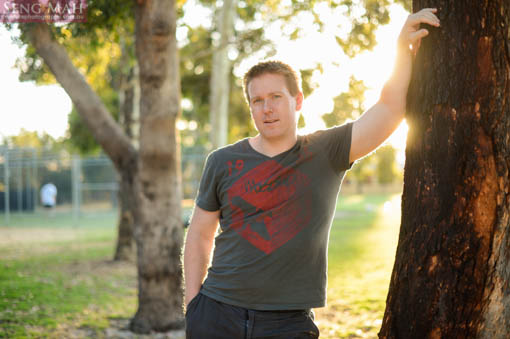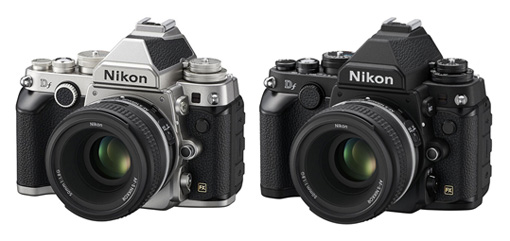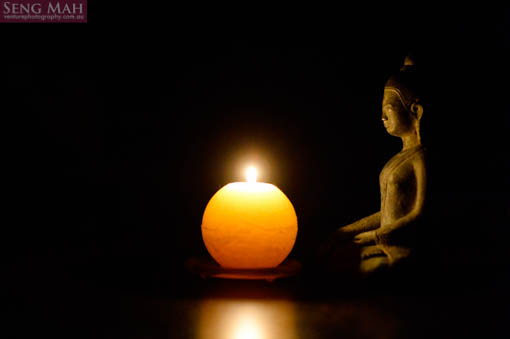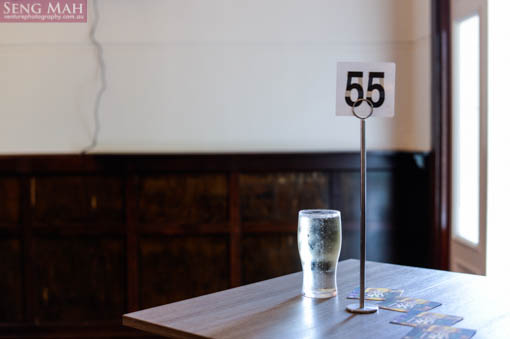REVIEW: Nikon Df – Everything Old is New Again!
One thing I’ve noticed about new camera reviews is that the reviewers somehow manage to find an attractive young woman to photograph as part of their field-testing. With this in mind, I had organised to shoot with a young model that I had recently discovered. Everything was planned – it was going to be a full-scale portfolio production at the West End of Fremantle, shooting against the beautiful glow of the setting sun at Slip Street and Arthur’s Head.
Then came the dreaded phone call on Sunday morning: my model had been stricken with the lurgi. Disaster! No pretty woman to photograph as part of my review of the Df.
Fortunately, I was able to call on a photographer mate of mind to get in front of the lens. Now, Dean isn’t a model, nor female, nor is he pretty (well, not to me anyway) – but he’ll have to do in a pinch.
So – I do apologise to those of you waiting with bated breath for the appearance of a gorgeous young woman bathed in the golden glow of the WA sunset, all captured with the remarkable sensor of the Nikon Df. You’ll have to make do with Dean instead, photographed at a local park. Here’s Dean, doing his “I’m a glamour model in golden back light” thing (he’s not actually a glamour model):

Ok, enough Dean. On to the Nikon Df.

This is Nikon’s retro-style DSLR camera – much publicised in the months leading up to its launch and, strangely, much reviewed even before it was released (the reviews were based on its specs rather than the actual camera – go figure). Does it live up to all the anticipation? Is it a game-changer? Will it change the face of photography for Nikon users?
It just might – but you’ll need to be a Nikon shooter to appreciate what the Df adds to the range. If you’re not a Nikon shooter, then you’re likely to complain about the interface and handling, but then again, you’re likely to complain about the same with the flagship Nikon D4 and D800.
The Nikon Df is a love letter to an older, gentler era when photography was slower and when the phrase “spray and pray” may be more aptly applied to horticulturalists confronting a locust plague than to photographers. It marries the interface previously found in the Nikon FA and FE series with superb digital photography functionality from the D800/E and D4. Nikon claims that the “f” stands for “fusion” and this is clearly the philosophy behind its design.
The Df is styled to resemble a Nikon FA or FE from the front – you can purchase it in black or silver. With a prime lens mounted, it looks appealingly old school.
The dials of the top of the Df could have come directly from an FA or FE SLR. There are two main sets of dials: one sets the ISO and EV compensation, the other sets the shutter speed. Shooting mode (PASM) is selected via a third, separate dial. The camera ON/OFF switch requires you to turn it instead of flicking it as you would with other Nikon DSLRs.

Top: Nikon FA; Middle: Nikon FE; Bottom: Nikon DF
These dials make the process of setting up your camera to take a photograph a very deliberate, tactile and considered one. It asks you to look at what you’re photographing, to carefully consider the light, aspect, depth of scene before manually selecting the exposure values from the range available on the dials. This retro interface gave me reason to pause and think before committing the frame by pressing the shutter button. It reminded me of shooting with my Dad’s Nikon FG-20, save that I could still enjoy the instant gratification of a digital preview.
If you use Nikon D lenses or non-CPU lenses, you can set the Df to use the aperture ring on these lenses for aperture control, effectively re-creating the classic FA/FE interface on a digital SLR! Shooting this way certainly foregrounds the physical act of taking a photograph where the button-pushing or quick-menu selection that digital photographers have grown used to is replaced with the physical tactility of setting dials and turning the aperture ring.
But shooting old-school style may not be something that you want to do all the time. Nikon is aware of this and this is where the “fusion” aspect of the Df comes to the fore.
The Df lets you turn it into a contemporary digital SLR with all the functions you’d come to expect of the D610/D800/D4. The shutter speed dial has a “1/3 Step” option, which lets you control the shutter speed via the main control dial. Doing this also usefully locks the shutter speed dial to “1/3 Step” so there’s no risk of your accidentally knocking it off this mode. Setting the aperture control back to the sub-control dial lets you then shoot with the Df as you would with a two-control dial Nikon DSLR.

Nikon Df – Back buttons
The back of the Df features all the familiar buttons from other Nikon DSLRs — the AEL/AFL and AF-ON buttons on top and, on the left, buttons that allow you to access playback, delete files, access the menu, change WB, Quality, flash EV (there is no pop up flash on the Df, so you’ll need to mount an SB speedlight) and bring up the Info screen on the LCD. Also on the back are the focus point lock switch, the exposure metering model selection switch and the Live View button. At the front left side is the autofocus switch that lets you switch between AF and MF, and the button that lets you switch AF modes (AF-S/AF-A/AF-C) and select your AF area.
With retro and modern controls, the Df quite elegantly straddles the divide between old and new: it’s a retro-styled camera that packs features that make it a fast and effective second body for a professional photographer or serious photography enthusiast.
For imagists, the beauty of the Df is that is uses the same, much-vaunted 16.2 MP CMOS sensor as the pro-level D4, but without the price-point of the D4. Much has been said about the D4 sensor’s amazing low-light capture ability – and this is very apparent in the Df. I took the Df on a visit to a historical village in Kalamunda and shot interiors at ISO 3200 – 6400 (the ISO range is extendable to ISO 204,800). Have a look at some of the images below, shown with sampled 100% crops to give you an idea of its high ISO performance. (Note: all images here are shot in FINE JPEG format as Nikon Df Raw file processing ability has yet to make it into the popular Raw processors and DNG converters).





100% crop – ISO1600


100% crop – ISO3200





100% crop – ISO5000


Like the D4, the Df is also fast auto-focusing in low light on its centre focus point. The following images was taken at ISO 6400 and 12,800 respectively in a space lit by a single-low burning candle and the camera acquired centre AF without a hint of “hunting”.


100% crop – ISO 6400


100% crop – ISO 12,800
If there’s a downside to the design of the Df, it’s the much smaller AF area in the 100% coverage viewfinder – I was disappointed to find that the 39 AF points so tightly clustered as to cover only a limited area in the middle of the viewfinder. Similar complaints had been made about the AF area in the D600/D610 that it was surprising that Nikon had not taken this on board in developing the Df. (The cynic in me reckons that this may have been a deliberate decision to hobble the Df so that the D4 still remains Nikon’s flagship superior sensor pro-level DSLR).
Tech aside, the Df handles very nicely. It is fairly light and about the size of a D600/D610. It’s certainly lighter than my brick of a D800 and is miniscule compared to the whopping D4. The lack of a more substantial grip on the shutter button side may throw first-time users but it doesn’t take long for the Df to feel “just about right” in one’s hands.
One of the main challenges the Df faces is finding its place among the range of new Nikon DSLRs currently on the market. It certainly isn’t trumpeting ground-breaking new technology and much of the advanced specs listed by Nikon already exist in higher end Nikon DSLRs such as the D4. In some respects, it cobbles some of the strongest features from Nikon’s pro-DSLR range into a retro-look body and presents itself as a highly stylised alternative to the D800 or D610. For photographers, the DF’s MP count makes it a better option as a second body than the high MP D800, and its D4 sensor makes it a much better performer in low-light photography than the D600/D610. Its size and weight make it a great alternative to the D800 or D4 if you’re looking for a high-performance camera that’s great for shooting on the run, whether street shooting or on trips and holidays.
The Nikon Df is the camera you buy because it is Nikon’s love letter to you (an AUD$3000+ love letter but still a love letter); but it is also the camera you buy because you’re looking for a back up second body that’s high on performance, low on bulk and which also looks very, very good. And just perhaps because you miss the old FA/FE series but you don’t have the time or patience to shoot film anymore.
Specs
- FX format sensor (16.2 MP), Expeed 3 image processor – identical to the Nikon D4.
- Pentaprism optical viewfinder with 100% coverage.
- ISO range 100 – 12,800. Extendable to ISO 50 – 204,800.
- 39 point AF system.
- 5.5 FPS continuous shooting (when compared the 6 fps on the D610 and 10 fps on the D4)
- Single SD card slot
- Compatible with AF Nikkor lenses including G, E, D, DX, AIP-Nikkor and non-CPU lenses.
- Shutter speed: manual dial (1/4000 – 4” in 1 EV Steps; 1/4000 – 30” in 1/3 EV Step mode), Bulb.
- Flash sync speed: 1/250
For more tech specs on the Df: https://mynikonlife.com.au/gear/digital-slr-cameras/df/features/tech-specs/
The Nikon Df provided for this review came courtesy of Team Digital — they’re great people to deal with and have Nikon Dfs in-store if you’d like to drop in and have a hands-on experience with this remarkable DSLR. Tell them I sent you. 🙂
Finally, here’s Dean again. Hopefully he was a more than adequate replacement for the pretty young female model who fell ill.








Jon
06/12/2013 at 12:55 pmGreat review and shots, thanks for taking the time – it was nice to read an honest review that didn’t bash the camera for looking good!
I’ve shot a D800 all year for weddings, and although I love it (a) the file sizes are bloody massive, and (b) I get slightly less keepers, especially wide open shots – that 36MP sensor shows up the tiniest motion or lack of critical sharpness.
So I’ve been seriously considering switching to a Df. I shoot all primes, so I’m not worried about the weight of the setup being unbalanced. The lack of 2nd card is a bit of a downer, but I do backup cards as soon as they come out anyway which helps a little. What are your thoughts on that being my main camera? Thanks in advance!
sengmah
09/12/2013 at 9:30 amHi Jon,
I remember shooting weddings with my D700 with its single CF card slot, so I don’t think having a single card is going to be much of an issue as long as you have a back up system handy. What makes the Df work for me as a potential wedding photography camera is the D4 sensor, which is going to make it great for low light photography.